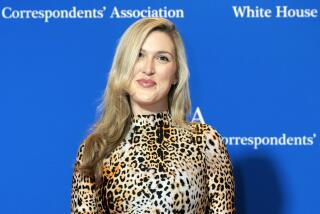They stoked the star-maker machine
WHAT is it about the public’s obsession with stars? The media has been enthusiastically covering Hollywood for 100 years, and today’s incessant, Internet-fueled celebrity “news” is omnipresent. The distribution methods have been dramatically accelerated, but the focus of the stories hasn’t changed much.
Variety began writing about films in 1907 because one-reel movies were shown between acts on the vaudeville stage or as “chasers” to clear out the audience before the next live performance. Within a decade, there were a slew of daily and weekly trades such as Exhibitors Herald, Motion Picture News, Moving Picture World and Film Daily, keeping everyone abreast of the business.
For the record:
12:00 a.m. June 23, 2006 For The Record
Los Angeles Times Friday June 23, 2006 Home Edition Main News Part A Page 2 National Desk 1 inches; 48 words Type of Material: Correction
Hollywood history: In the special 125 Years/Hollywood section that was published May 21, a photo of Natalie Wood and Tab Hunter at the 1956 Academy Awards identified the woman taking notes next to them as gossip writer Louella Parsons. The woman wasn’t Parsons; her identity is not known.
For The Record
Los Angeles Times Sunday June 25, 2006 Home Edition Main News Part A Page 2 National Desk 1 inches; 46 words Type of Material: Correction
Hollywood history: In the special 125 Years/Hollywood section published May 21, a photo of Natalie Wood and Tab Hunter at the 1956 Academy Awards identified the woman taking notes next to them as gossip writer Louella Parsons. The woman wasn’t Parsons; her identity is not known.
By the late teens, New York was the financial center of moviemaking, but there were more than 100 film companies in Los Angeles and the industry had become the area’s largest source of employment. And there was plenty to cover. Columns such as “Inside the Studios” reported on the activities of directors and writers as often as actors and “What This Picture Did for Me” shared information on how films were promoted in the hinterlands.
The first real fan magazine was Photoplay, which began in 1912 to provide synopses of the plots of films. Pictures of actors accompanied the stories as if they were an afterthought, but soon it was the stars themselves who took center stage. There, in the very first issue, was a photo of “Little Mary” in her role as Little Red Riding Hood. And as the allure of the movies caught on, what many readers wanted to know was the real name of the “girl with the curls”; soon pages of photographs of Mary Pickford “happily at home” with her husband, Owen Moore, were what was selling Photoplay.
Pickford’s real-life drama spilled over into the newspapers, including the Los Angeles Times and the New York Times, in March 1920 when they reported the emotionally draining daily progress of her divorce from Moore. There she was in Nevada, claiming she was making “the state her permanent home” (which also allowed the process to take a few weeks instead of a year). The next day she was on the witness stand, “weeping freely” as she told the judge tales of her husband’s mental cruelty.
After publicly vowing she would “never marry again,” she privately told friends she was tired of being “America’s sweetheart.” In truth, she wanted to be one man’s sweetheart. That one man was Douglas Fairbanks, yet she feared losing her career to the negative reaction of the fans she called “my people.” She was the most famous actress is the world, yet stardom was a new phenomenon. Young girls in Kansas City, such as the one who would become Joan Crawford, clipped the articles of their favorite stars and put them into scrapbooks, yet for Pickford, there was no precedent or path to follow.
When she married Fairbanks later that year, Pickford was blissfully relieved to find headlines crowning the newlyweds the king and queen of Hollywood. He was an affable star and Pickford had portrayed the sweet young thing for so long that the power of their image carried over into the press.
On-screen naivete, however, was hardly enough to spare the beloved comedian Roscoe “Fatty” Arbuckle when he was charged with manslaughter in the death of Virginia Rappe during a party in San Francisco in 1921. His trials galvanized the attention of everyone who had ever blamed Hollywood for postwar cultural changes or loose morals. The jury eventually found him not guilty and issued Arbuckle an extraordinary apology. Yet the vociferous press coverage of the 300-plus-pound Arbuckle had transformed him from harmless naif to an obscene sexual predator. The studio heads were so afraid of the resulting frenzy that the comedian was banned from the screen despite his innocence.
The conversion from silent to sound films brought growing Wall Street investment to Hollywood, and soon newspapers’ business sections were filled with reports of mergers and stock offerings. Personality pieces, reviews and syndicated columns surrounded theater advertisements on the pages of features sections. The first woman to grace the cover of Time magazine was stage actress Eleanora Duse, but it wasn’t long before Jean Harlow, Marlene Dietrich and Rita Hayworth were cover girls as well.
Studio heads saw radio as a potential threat, but instead their movies, and their actors, became a useful source of programming. Beginning in 1931, the Academy Awards ceremony was broadcast across radio waves; a boomlet of programs such as “Hollywood Hotel,” “Gateway to Hollywood” and “Hollywood Premieres” focused on the latest from the entertainment capital.
Television’s popularity sent similar shivers through Hollywood, yet studios quickly took advantage of the new medium with programs such as “MGM on Parade” and “Walt Disney Presents” as well as selling their films for broadcast.
While Silver Screen, Picturegoer and other glossy magazines filled the stands, it was to the daily newspaper that movie fans usually turned for their entertainment news. Frequently, that meant reading Louella Parsons in the L.A. Herald and the Hearst newspaper chain. While she had a variety of competitors over the years, it wasn’t until the late 1930s that her legendary rival, Hedda Hopper, arrived on the scene.
Hopper was a down-and-out actress who had turned to real estate and agenting to support herself and was already in her early 50s when the Los Angeles Times was the first to buy into her effort at syndicating a Hollywood column. Moguls such as Louis B. Mayer had tired of Parsons’ pushy threats to cover -- or even worse, withhold coverage of -- certain luminaries and he gave the OK for his right-hand woman, Ida Koverman, to throw Hopper a “welcome to Hollywood” party. The gathering ordained Hopper’s credibility, and so the first guns were fired in what would become a 25-year reign for the dual monarchy.
Between them, they claimed 75 million readers. They may have fought for exclusives, but neither Hopper nor Parsons ever had to deign to actually ask for cash for coverage. Their holiday haul included a Rolls-Royce for Hopper as well as literally thousands of presents amassed at her Tropical Avenue home. Parsons received as much or more and went so far as to let it be known she wanted no gifts that featured her initials; what she didn’t directly mention was that monograms made items so difficult to return or resell. Miss Parsons liked to believe the annual bounty was a reflection of people’s genuine affection for her, but Hopper referred to the plethora of packages she received as “loot through fear.”
The fear they generated was real, particularly when Hopper laced her political opinions in between tales of celebrity sightings. Others in Hollywood might be bowing to her, but she was fawning over J. Edgar Hoover, telling the FBI director to just “give me material and I’ll blast.” And blast she did, leading the attack that eventually drove left-leaning Charlie Chaplin to a life in Switzerland. The director Jules Dassin, who was harangued for his leftist politics and fled for Europe, pronounced: “The tragedy of Hollywood is that for over a quarter of a century it was harried by these two illiterate, vindictive women.”
Columnists such as Dorothy Manners and Joyce Haber filled the column space after Parsons and Hopper faded to black in the mid-’60s, but never with the same vociferous passion. Yet then, as now, their fodder was the personalities we felt we knew from seeing them on the screen.
“From the very beginning,” Mary Lea Bandy, chief curator of the Museum of Modern Art film department, says, “we have seen movie stars as the people we wish we could be, who are living the lives we wish we could lead.” Pickford had a syndicated column that professed to provide insights into her private life, but it had nothing on US Weekly’s blatantly entitled column “Stars -- They Are Just Like Us” or today’s onrush of gossip -- from the sublime to the vicious -- on websites such as Defamer.com or Awfulplasticsurgery.com.
And it isn’t just pretty faces who command our attention. Cliff Robertson was more than frustrated when he found himself owing taxes on money Columbia chief David Begelman had stolen via forged checks. The story eventually erupted into a scandal of, well, Hollywood proportions in 1977 when Robertson went to the Washington Post with the story no one else wanted to hear.
Now it is jailed private eye Anthony Pellicano and his A-list associates who are the subject of a competitive feeding frenzy. The increasing number of celebrities caught in the Pellicano web has created the unusual situation of Variety reporting on what the New York Times says the FBI said. It is a complicated and expanding story, yet too complicated for the phrasemakers of the tabloids to grab onto.
“It is part of the human DNA for us to be interested in other people’s lives,” says Graydon Carter, editor of Vanity Fair, but he also points out that in the past, one had to have actually accomplished something to be a public figure. Today, “you only need be a reality show contestant and willing to spill your life in the interest of fame.” That fame is usually fleeting and often eventually breeds contempt, but it burns brightly while the spotlight is on.
Living vicariously through other people’s lives, like the movies themselves, is a surefire diversion from the problems of the real world, but our interest in celebrities is at an all-time high. “The pipeline that needs to be filled today is massive, but the level of information gauged interesting enough to print is mind-boggling,” says novelist and New York Magazine columnist Kurt Andersen. “I think it is a fair bet -- or perhaps just wishful thinking -- that celebrity ‘news’ is at its zenith.” Then he adds, “Of course, that’s what I thought about 12 years ago.”
Ask the editors and they will tell you they are just giving the public what they want, but that begs the question: Are they really being inundated with requests for more details on the life and loves of Nicole Ritchie?
Cari Beauchamp is the author of “Without Lying Down: Frances Marion and the Powerful Women of Early Hollywood” and other books. Her latest book is “Adventures of a Hollywood Secretary: Her Private Letters from Inside the Studios of the 1920s.”
More to Read
The biggest entertainment stories
Get our big stories about Hollywood, film, television, music, arts, culture and more right in your inbox as soon as they publish.
You may occasionally receive promotional content from the Los Angeles Times.










